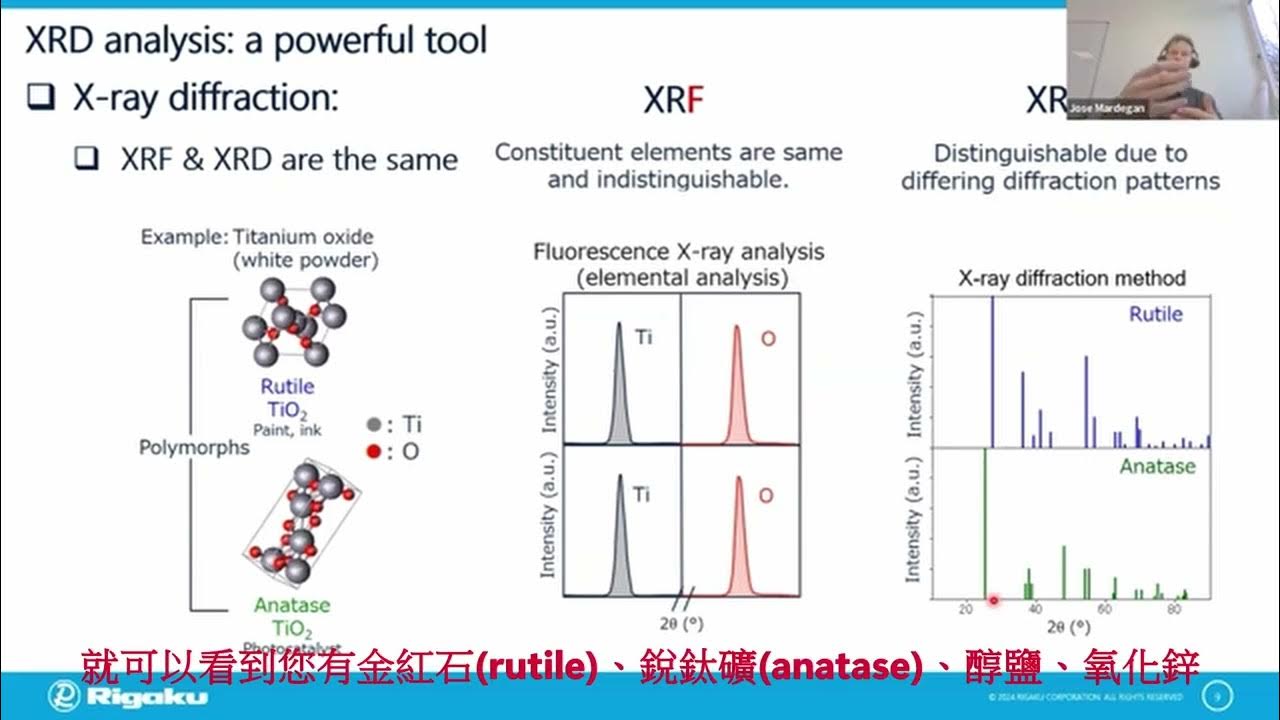UAD - Kuliah Online 1475530 Karakterisasi Material Lanjut (Lecture 1b)
Summary
TLDRThis video script delves into the physics of X-ray diffraction and the application of Bragg's law to analyze crystal structures. It explains how X-rays interact with various planes in a crystal, focusing on the relationship between diffraction angles, lattice spacings, and diffraction orders. The script highlights the calculations for determining diffraction angles, using examples from iron crystals, and discusses how to interpret diffraction patterns to reveal structural details. With technical explanations and mathematical formulas, the script is aimed at viewers seeking to understand the core principles of X-ray diffraction in crystallography.
Takeaways
- 😀 The script focuses on the principles of X-ray diffraction (XRD), emphasizing the role of diffraction angles and crystal lattice structures in determining the diffracted beams.
- 😀 The diffraction condition is expressed as 2D * sin(θ) = nλ, which relates the wavelength (λ) and the distance between crystal planes (D) to the diffraction angle (θ).
- 😀 The interference patterns observed in X-ray diffraction depend on the difference in the path lengths of the X-ray beams reflecting off different crystal planes.
- 😀 When the distance between two X-ray beams is an integer multiple of the wavelength, constructive interference occurs, resulting in diffraction maxima.
- 😀 The diffraction angle (θ) changes with varying distances between crystal planes (D), which can be affected by rotating the crystal or altering its structure.
- 😀 A smaller D (distance between crystal planes) leads to a larger diffraction angle (θ), and vice versa. This relationship is crucial in determining diffraction patterns.
- 😀 The script mentions several crystal structures, including cubic, orthorhombic, and tetragonal, and explains how to calculate the interplanar distance (D) for these structures.
- 😀 The diffraction angles are affected by the indices of the crystal planes (hkl), and the smallest diffraction angle corresponds to the largest D value.
- 😀 The calculation of diffraction angles is demonstrated with specific examples, including the use of a wavelength of 0.154 nm for X-ray diffraction with a given crystal.
- 😀 The script emphasizes the importance of understanding diffraction patterns, as they provide valuable information about the crystal's structure and the arrangement of atoms.
- 😀 The process of calculating diffraction angles and intensities involves using the equation 2D * sin(θ) = nλ and applying it to various planes with specific hkl values for accurate results.
Q & A
What is the core concept discussed in the video transcript?
-The transcript primarily discusses the principles of X-ray diffraction and how it relates to crystallography. It explains the relationship between the angle of diffraction, the wavelength of the X-rays, and the interatomic spacing in crystals, using the Bragg equation for diffraction.
What is the Bragg's law equation mentioned in the script?
-The Bragg's law equation mentioned is: 2D * sin(θ) = nλ, where D is the spacing between crystal planes, θ is the angle of diffraction, n is the diffraction order, and λ is the wavelength of the X-ray.
How does the distance between crystal planes (D) affect the diffraction angle (θ)?
-The diffraction angle θ is inversely proportional to the spacing D between the crystal planes. As the distance D increases, the diffraction angle θ decreases, and as D decreases, θ increases.
What type of crystals does the transcript refer to for demonstrating X-ray diffraction?
-The transcript refers to cubic crystals, specifically mentioning simple cubic structures where the lattice parameters (a, b, c) are equal and the angles between the axes are 90°.
What is the significance of the Miller indices (hkl) in crystallography as discussed in the transcript?
-Miller indices (hkl) are used to describe the orientation of crystal planes in the lattice. They help determine the distance between these planes, which influences the diffraction pattern and angles at which diffraction maxima occur.
How is the diffraction angle θ related to the Miller indices (hkl)?
-The diffraction angle θ is influenced by the Miller indices (hkl) because the distance between the planes (D) is determined by the values of h, k, and l. Larger Miller indices correspond to smaller interplane distances and thus result in higher diffraction angles.
What are the key steps involved in calculating the diffraction angles for a given crystal structure?
-The key steps involve: (1) determining the interplanar spacing (D) based on the Miller indices and lattice parameters, (2) applying Bragg's law (2D * sin(θ) = nλ) with the given X-ray wavelength (λ) to solve for the diffraction angle θ.
What practical example is given in the transcript to calculate diffraction angles for a specific crystal?
-The transcript uses the example of an iron (alpha-Fe) crystal with a body-centered cubic (BCC) structure and a lattice constant of 0.2 nm. X-rays with a wavelength of 0.154 nm are used to calculate the diffraction angles for different Miller indices.
How does the wavelength of the X-rays (λ) affect the diffraction pattern?
-The wavelength λ affects the diffraction pattern by determining the angle at which diffraction maxima occur. A shorter wavelength leads to diffraction at smaller angles, while a longer wavelength results in diffraction at larger angles for the same interplanar spacing.
Why is the multiple diffraction order (n) important in the analysis of diffraction patterns?
-The multiple diffraction order (n) is important because it indicates different diffraction maxima corresponding to different integer multiples of the basic diffraction angle. The most intense diffraction peaks usually occur at the first order (n = 1), but higher orders (n > 1) can also appear at different angles depending on the crystal structure and X-ray wavelength.
Outlines

This section is available to paid users only. Please upgrade to access this part.
Upgrade NowMindmap

This section is available to paid users only. Please upgrade to access this part.
Upgrade NowKeywords

This section is available to paid users only. Please upgrade to access this part.
Upgrade NowHighlights

This section is available to paid users only. Please upgrade to access this part.
Upgrade NowTranscripts

This section is available to paid users only. Please upgrade to access this part.
Upgrade NowBrowse More Related Video

Constructing an Ewald Sphere

Prinsip Kerja XRD (X-Ray Diffraction) | Hukum Bragg | Bahasa Indonesia

Webinar 2

BTECH PHYSICS | DAVISSON GERMER EXPERIMENT |APPLIED PHYSICS|DUAL NATURE of Radiation Telugu #btech

UAD - Kuliah Online 1475530 Karakterisasi Material Lanjut (Lecture 1c)

4B Planos cristalográficos - Difração de Raios X
5.0 / 5 (0 votes)